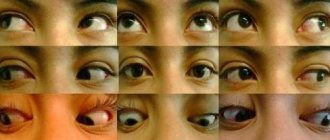Alice in Wonderland syndrome: what to do if a child has micropsia
Psychotherapist of the highest category Oleg Viktorovich
38250
Update date: June 2020
Alice in Wonderland syndrome is a disease that is a neurological disorder manifested by a distortion of the perception of the surrounding world. In this case, objects appear unrealistically large or small, boundaries and distances appear different from reality.
What is Alice in Wonderland syndrome?
Alice in Wonderland syndrome is temporary and episodic, appearing and disappearing suddenly
In accordance with the International Classification of Diseases (ICD-10), Alice in Wonderland syndrome is included in the R40-R46 group, which unites any manifestations relating to the ability to cognition and perception, emotions and behavior.
Etiology
Pathology develops, as a rule, in children aged five to thirteen. However, occasionally, it is also observed in adults (the onset of the disease in this case occurs at the age of 20-25 years).
The disease is considered a rare disorder and is characterized by a relapsing course - a distortion of reality is observed only in periods.
Causes
There is no clear opinion about the reasons for which the syndrome develops. According to researchers, the disease may be a consequence of:
- frequent migraine attacks, accompanied by prolonged and debilitating headaches;
- schizophrenia (a serious mental illness requiring appropriate treatment);
- infectious mononucleosis, which has spread to certain parts of the brain;
- seizures during epileptic attacks accompanied by hallucinations;
- oncological diseases of the brain.
The onset of the disease is usually preceded by:
- physical effects on the brain - consequences of injuries, infections, intoxications, radiation exposure, etc.;
- psycho-emotional impact – conflict and stressful situations, depressive states that last a long time.
Risk factors are:
- use of any drugs;
- personal characteristics of a person, for example, suspiciousness and susceptibility to psycho-emotional influences;
- instability of the nervous system.
Symptoms
People with Alice in Wonderland syndrome experience panic attacks during attacks
Alice in Wonderland syndrome is accompanied by attacks lasting from a few seconds to several days (in some cases their duration can reach a month).
The main sign of pathology is a distortion of spatial perception:
- unexpected increase or decrease in size of surrounding objects;
- reducing or increasing the distances between objects and changing their proportions.
People with Alice in Wonderland syndrome perceive a distorted image as absolutely real, which can be accompanied by loss of orientation in space and severe fear, which can lead to the development of a phobia.
In addition to distortion of the proportions of objects, patients experience:
- tachycardia;
- increased breathing;
- panic attacks.
In some cases, the attack is preceded by pain, reminiscent of migraine in its severity and duration.
Stages and forms
An attack accompanied by a distortion of reality occurs in several stages.
- The initial stage is characterized by the appearance of a headache or general anxiety with a gradual or sudden increase in symptoms.
- The main stage is accompanied by the most severe manifestations of pathology.
- At the final stage, the severity of symptoms decreases, patients experience fatigue, apathy, and drowsiness.
Depending on the clinical manifestations, Alice in Wonderland syndrome is divided into several types:
- macropsia, accompanied by a sudden strong apparent increase in surrounding objects and distances;
- micropsia, characterized by an apparent decrease in everything that surrounds a person.
Consequences and complications
The consequences of Alice in Wonderland syndrome can vary.
Some patients completely withdraw into themselves, avoid communicating with friends and acquaintances, try not to leave the confines of their own home, and especially not to visit crowded places.
Others become depressed, feel hopeless, and lose their ability to concentrate.
Still others lose their ability to work and become objects of ridicule from others, including loved ones.
At the same time, a depressive, depressed state that does not stop for a long time is accompanied by various somatic disorders. In the vast majority of cases, the nervous, cardiovascular and digestive systems suffer from them.
Diagnostics
After the conversation, the psychiatrist can involve doctors of other specializations
The diagnosis is made based on information obtained during a survey of the patient. Laboratory and instrumental diagnostics are practically not used in this case, which is explained by their low information content.
The examination is carried out by a psychiatrist. If necessary, consultations with other specialists are prescribed - a neuropsychiatrist, a therapist, a narcologist.
What to do with micropsia or macropsia?
Micropsia (macropsia) is treated purely individually. If the cause of the disease is discovered, therapy is aimed at eliminating it (at the same time, accompanying symptoms are also relieved). So, for migraines, painkillers and sedatives are prescribed, for epilepsy, relaxants and anticonvulsants are prescribed.
To lengthen periods of remission, patients are recommended to take a course of classes with a psychologist or psychotherapist. Such activities help reduce the severity of fears and relieve the depression that accompanies them.
The support of family and loved ones also plays a huge role in the treatment of the syndrome. Sick people should not be left alone with the problems that have befallen them, especially if the disease developed in childhood.
Sessions of hypnosis and cognitive behavioral therapy can enhance the positive effect of treatment.
Drug treatment
Drug treatment is used to reduce the severity of disturbances in the perception of reality. In the vast majority of cases, micropsia (macropsia) is treated with the following drugs:
- sedatives;
- antidepressants;
- benzodiazepines;
- nootropics.
Prevention
Yoga classes will help you cope with emotions during attacks and teach you how to control yourself
There are no specific ways to prevent Alice in Wonderland syndrome. As a rule, for this purpose, recommendations that are general for the prevention of all such conditions are used.
To prevent micropsia (macropsia) from appearing, you must:
- cultivate resistance to stress;
- have a full rest, walk in the fresh air, lead an active lifestyle - this will strengthen both physical and mental health;
- do yoga, meditate - this will help relieve stress, relax, and strengthen the nervous system;
- Eat right – your diet should not contain foods that can trigger migraine attacks.
Forecast
To date, Alice in Wonderland syndrome is an insufficiently studied mental disorder, and therefore there is no unambiguous treatment regimen for this pathology.
A competent approach to treatment and correctly selected medications help lengthen periods of remission and shorten the duration of attacks, which, in turn, facilitates the social adaptation of patients, expands their social circle, and restores their ability to work. However, it is not yet possible to completely cure the disease.
Source: https://mozg.expert/sindromy/sindrom-alisy-v-strane-chudes/
Alice in Wonderland syndrome - what is it, symptoms
Alice in Wonderland syndrome refers to hallucinatory and illusory mental disorders, which are the subject of close scientific interest among doctors and psychologists.
This psychopathology occurs in children and adolescents. The syndrome has specific manifestations and features. To overcome the disease, it is important to know the reasons that provoke it.
Psychiatrists, clinical psychologists and neurologists treat Alice in Wonderland syndrome in children.
What is Alice in Wonderland syndrome
In the course of scientific research, experts in the field of medicine and related sciences came to the conclusion that Alice in Wonderland syndrome is a psychoneurological disorder in which the patient perceives the surrounding reality in a distorted form.
According to ICD-10, this disorder is classified as micropsia or macropsia. The disease is also known as Todd syndrome.
In psychiatry, this disorder was discovered by Lippmann in 1952. He explained the symptoms of this syndrome by the psychophysiological connection between micropsia and migraine. In 1955 J.
Todd experimentally established that patients during a migraine attack actually perceive the surrounding reality distorted, after which he described in detail the clinical picture of the disease and established its causes.
From a physiological point of view, distortion of perception occurs as a result of disruption of the tone of blood vessels in the brain as a result of a sudden spasm. At the same time, the brain experiences oxygen starvation, which negatively affects its functioning. Visual hallucinations are formed as a result of a sharp narrowing and slow dilatation of blood vessels.
How does the syndrome manifest?
Most often, the manifestations of the syndrome are similar to a migraine attack. Todd's syndrome is based on a violation of all types of perception. At the same time, a person cannot distinguish illusions from reality. During an attack, he does not feel the boundaries of his body and loses the ability to navigate in space. This is accompanied by a distorted perception of time.
The symptoms of Alice in Wonderland syndrome explain a person's situational anxiety and panic attacks.
Forms and stages of the syndrome
The most common manifestations of the syndrome are metamorphopsia, micropsia and macropsia.
Metamorphopsia is a person’s distorted perception of the image of his own body and its individual parts.
Micropsia is a perception disorder in which all objects in the surrounding reality are perceived in a greatly reduced form.
Macropsia is a perception disorder in which all objects in the surrounding reality are perceived as extremely large.
Both of these forms of Todd syndrome have several stages:
- Initial stage. The occurrence of headaches, increased anxiety. The intensity of these symptoms increases rapidly.
- Main stage. A pronounced manifestation of the disease, complex symptoms of distorted perception.
- The final stage. Reducing the intensity of the syndrome. Fatigue, apathy, drowsiness.
Diagnosis and treatment
Parents may not immediately notice macropsia or micropsia in a child, since preschoolers and primary schoolchildren are characterized by fantasies: based on children's statements, it can be difficult to distinguish micropsia in a child from a simple play of imagination.
Diagnosis of the disease is complicated by the fact that there are no effective instrumental and laboratory methods for identifying this pathology. The psychiatrist makes a diagnosis based on the patient's complaints. For a comprehensive examination, the psychiatrist recommends consultation with a neurologist and a clinical psychologist.
Treatment of Todd's disease should begin with identifying the causes of micropsia or macropsia. The main means of relieving Alice in Through the Looking Glass syndrome are drugs that help cope with migraine attacks. Medications reduce the intensity of symptoms.
To treat micropsia in a 7-year-old child, anticonvulsants, nootropic and sedatives are prescribed. In adolescence, with the help of antidepressants and benzodiazepines, it is possible to minimize the manifestations of Alice in Wonderland syndrome, which is explained by the psychological characteristics of the puberty period.
What to do with micropsia and macropsia
It is known that micropsia in a child is a disease caused by the individual and personal characteristics of the patient. Only a doctor can choose the correct treatment.
A child facing this illness should feel the support of adults.
Based on the fact that macropsia and micropsia are neurological disorders, upon discovering their symptoms, you need to undergo a thorough examination.
If you experience severe anxiety and worry, you should enroll in a course of psychotherapy. Cognitive behavioral therapy and hypnosis have proven themselves to be effective in relieving Todd syndrome.
Prevention and prognosis
To prevent the development of Alice in Wonderland syndrome, experts recommend:
- observe the work and rest schedule, avoid overwork;
- Healthy food;
- play sports, lead an active lifestyle;
- master yoga and meditation;
- systematically train visual perception;
- increase stress resistance.
Source: https://lifemotivation.ru/samopoznanie/sindrom-alisy-v-strane-chudes
Micropsia (Alice in Wonderland syndrome, Lilliputian vision): causes and treatment methods
There is hardly a person who has not read Lewis Carroll's fairy tale “Alice in Wonderland.” The fairy tale is a lie, but there is a hint in it. It turns out that the plot was not entirely invented by the author.
Doctors are aware of diseases such as micro- or macropsia , which are also called Alice in Wonderland syndrome .
This strange and rare disease is characterized by a violation of a person's perception of reality.
DON'T BELIEVE YOUR EYES
People suffering from Alice syndrome see surrounding objects and parts of their body not at all as they really are, they lose the ability to perceive their true size.
In addition, there may be a violation of temporal and spatial orientation, manifested in an increase or decrease in visual images. Imagine that right before your eyes, some part of the body suddenly stretches out and changes proportions.
And, surprisingly, it happens suddenly.
The same thing is happening in the world around us. A huge boulder on the road turns into a small pebble that seems easy to step over. And thanks to its new size, an elegant wristwatch can easily crush its owner. Of course, this mental disorder cannot but affect all of a person’s senses, especially vision.
In addition, time can either speed up or slow down for such people. Didn't Alice in Wonderland experience the same sensations? That is why the syndrome got its name.
For those suffering from Alice syndrome, the world around them changes overnight. For example, the floor suddenly takes on a vertical position, and the walls of the rooms close together. Chairs, tables, bedside tables and other pieces of furniture miraculously rise into the air and spin in a strange and frightening dance. The door handle turns out to be the size of a door...
However, most often it is not macro-psia, but micropsia, when objects become much smaller in size than they really are. It is not surprising that in such a situation a person completely loses control over reality.
TWISTED REALITY
In scientific terms, micropsia is a disorienting neurological condition that manifests itself in a person’s visual perception of surrounding objects proportionally reduced.
Synonyms for the name of the disease are “dwarf hallucinations” or “Lilliputian vision”.
However, in reality there are no problems with the eyes; changes occur only at the level of the psyche, which imposes distorted visual, auditory and even tactile sensations on the patient.
That is, the brain incorrectly perceives the information it receives from the eyes. Either the spoon becomes the size of a shovel, then the sofa turns into a doll's, then the pile of garbage on the floor becomes like a mountain. You can never predict in advance what terrible pictures the next attack will show.
The patients themselves say that during attacks of the syndrome, the feeling of stability is lost: the floor becomes wavy, but at the same time the legs get stuck in it, like in soft clay. It must be said that attacks can last from a few seconds to several weeks. Those who have visited this terrible “fairy tale” several times become alarmed, frightened and are constantly in a state of panic.
WHY?
The reason that forces a person’s brain to transfer him to a strange world of distorted reality has not yet been found out. There are only suggestions that this may be due to a hereditary predisposition to migraines.
Source: https://gudi1991.ru/uspeh/makropsiya-eto.html
Micropsia
There are diseases that are classified as mysterious, inexplicable, and micropsia is one of them. In medical practice, this is the name for a neurological condition that causes a person to experience an absolute distortion of reality. Micropsia is also called Alice in Wonderland syndrome.
It is known that people suffering from this disorder often see things differently from what they really are. Micropsia is considered a neurological disorienting condition, under the influence of which a person perceives any objects to be proportionally reduced.
The disease has synonymous names, you can find the definition “dwarf hallucinations”, micropsia is also called Lilliputian vision. Regardless of the terminology, the essence of this phenomenon is always the same.
The eye itself has no damage, and only changes in the psyche occur.
What do scientists know about this disease today, what are the symptoms of this disease? You should know how micropsia manifests itself.
Treatment
With micropsia, there is no treatment specific to this condition; the disease is treated like a migraine.
The duration of the attacks varies, it may not exceed a few seconds, or sometimes the condition does not go away for weeks.
As for the retina, it remains unchanged, and the patient’s eyes remain healthy, since the changes directly affect the psyche. That is, the brain distorts the information received from the eyes.
After several attacks, a person develops fear, he becomes anxious, afraid, and often simply panics. Experts believe that the disease will soon be treated, and returning to the real world will not be difficult.
The disease was first noted in 1952 by Dr. Lippan, but an accurate description was given three years later by Canadian neurologist John Todd. The doctor gave a detailed description, trying to find out what was causing it.
Today's science believes that the neurological manifestation of the disease is represented by disorders in the parietal region of the brain. In addition, taking into account the existing features, they are comparable to those observed with migraine. Treatments prescribed for migraines are not always effective if a person has micropsia, but they do help most people.
Features of the disease
Currently, the disease is considered poorly understood, the reasons for the development of micropsia are not clear, and therefore there are no clear methods that ensure a quick and unambiguous recovery.
However, it is important to be aware of the presence of symptoms such as confusion, which may place the patient's life at serious risk.
Therefore, if signs of this strange illness occur, it is necessary to carry out treatment and not leave the condition unattended.
What is the main treatment? Mainly, the therapeutic effect is aimed at combating the main factors, and not their consequences, for which the patient is given drug therapy. Basically, painkillers are required, the same as for migraines.
Many people are interested in whether there are preventive methods to prevent microscopic attacks. It is important to follow a daily routine here. So, a person should sleep normally, an average of eight hours. You need to take food three times a day, and at the same time exclude harmful foods, be sure to follow the routine.
It is important to try to avoid stressful situations and various conflicts. Moreover, especially difficult are the circumstances in which the occurrence of symptoms entails a certain danger. This applies to swimming in open water, extreme sports, driving a car or other transport.
We should not forget that children do not experience fear when symptoms arise, microscopy does not frighten them, and on the contrary, it may seem funny. Such a child should be surrounded with constant care, understanding and patience should be shown in order to obtain a favorable outcome of the situation.
As for adult patients, many begin to panic and worry excessively, as they understand that what is happening is unnatural. Micropsia is dangerous; if you notice the signs, you must promptly obtain medical advice and begin treatment.
Source: https://www.psyportal.net/18778/mikropsiya/
Clinical manifestations and specific treatment of Alice in Wonderland syndrome
Alice in Wonderland syndrome is a group of neurological disorders associated with distortion or deformation of the perception of the surrounding world. Currently, there are 2 forms of the disease – micropsia and macropsia.
Alice Through the Looking Glass Syndrome is a name taken from a famous children's book in which the main character ended up in a place where the size of surrounding objects was unnatural.
Similar disorders occur in patients suffering from this disease.
Prerequisites
The exact reason why Alice in Wonderland syndrome develops is unknown in medicine. However, there are a number of factors, according to doctors, that provoke this disorder. In most cases, the formation of Alice in Wonderland disease is associated with concomitant pathologies, in which patients’ perception of the world around them changes.
Possible causes of micropsia and macropsia:
- Migraine. The systematic development of debilitating headaches leads to a distorted perception of the surrounding reality. At first, the disorder appears only during migraine attacks. If it occurs regularly, attacks of pathology also develop at the same time.
- Schizophrenia. This mental disorder is accompanied by a distortion of perception. At the same time, the patient often has the feeling that he is not who he really is. The disease is considered severe and difficult to treat. Often therapy is reduced solely to eliminating symptoms.
- Altered state of consciousness. Attacks of Alice Through the Looking Glass syndrome often develop in people experimenting with substances that affect the perception of the world. These drugs include drugs and some types of alcohol. Also, a distortion of the worldview is achieved by prolonged refusal of sleep, the use of hallucinogenic mushrooms, herbal mixtures for smoking, and breathing practices.
- Brain diseases. Various pathologies of the brain centers responsible for the perception and processing of information received from the outside world can cause disruption. Possible diseases causing the syndrome include brain cancer, mononucleosis, and epilepsy.
In general, macropsia or micropsia in an adult develops due to disruption of the centers responsible for perceiving the surrounding world.
Clinical manifestations
The pathology occurs in the form of attacks. The frequency of their occurrence, as well as the duration, differs depending on many factors. There are cases where the attack lasted more than a month. However, the disease can manifest itself for several minutes.
Signs of pathology:
- Changes in the size of surrounding objects (increase with macropsia or decrease with micropsia).
- Distortion of the distance between objects.
- The appearance of a difference in proportions between surrounding objects.
- Disorientation in space.
- Distortion of time perception.
- Memory losses.
- Feelings of anxiety, fear, panic.
- Inability to coordinate actions.
- Headache.
- Fever.
- Cardiopalmus.
- Excessive sweating.
One of the features of the described syndrome is that a distortion in the perception of the environment occurs in the patient even if he is in a supine position with his eyes closed. In this way, an ophthalmological abnormality is excluded.
Alice through the looking glass syndrome is accompanied by a number of severe symptoms that are paroxysmal in nature.
First aid
If an attack occurs, there is a serious danger for the patient, especially if he is on the street.
Disorientation in space and distorted perception of the world can cause injury or other damage.
An attack in a child poses a great danger, since in childhood such pathologies can lead to disruption of the formation of mental processes and functions.
During an attack, you should take a comfortable position. It is recommended to do breathing exercises, as they help saturate the brain with oxygen. If necessary, take medications for migraines and high blood pressure. It is strictly forbidden to drive. If the victim is on the street, he should call a loved one who will take him home and help him calm down.
Use of medications
In psychiatry, there are no special drugs to eliminate seizures. A patient suffering from the syndrome is recommended to always have Corvalol or Validol with him, due to which normal heart function is restored during a panic attack.
The following groups of medications can be used for therapeutic purposes:
- Sedatives.
- Antidepressants.
- Tranquilizers.
- Vasodilators.
Pharmaceutical formulations are prescribed by the attending physician depending on the suspected cause and the individual characteristics of the patient.
Causes
Micropsia is a disease characteristic of children from three to thirteen years old; as a rule, after the end of puberty, attacks occur less frequently, and by the age of thirty they disappear completely. Therefore, if symptoms occur in a child, do not panic. This phenomenon has not been fully studied, so it is impossible to clearly and unambiguously determine the cause that gave rise to the symptoms. However, there are a number of factors that provoke the occurrence of the disorder:
- Epstein-Barr viral infections;
- malignant brain tumor;
- mononucleosis;
- epilepsy;
- fever;
- schizophrenia;
- use of hallucinogens;
- migraine.
It is also common to consider micropsia against the background of a mental disorder, and not as a separate stable disease.








